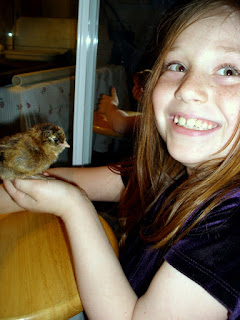 |
| Lovelace, one of our first hens--a Gold Laced Wyandotte |
 |
| Winter 2011--over 1' of snow in the chicken yard |
But what about the particular things about chickens you may not be aware of? Keep this in mind as you consider raising backyard birds.
For starters, you have to keep to their schedule.Unless they are free-ranging, and find their own homes in trees or on roofs at night (and you accept the inherently predictable losses to predators that will occur in your flock over time), your chickens need to be out of their coop soon after sunrise, but certainly by 7:30 am or so. If you sleep in, they are likely to fight in the "cooped up" space, and while they aren't potty trained, they prefer to poop outside the coop--as long as you make sure they can do so by the time they are fully awake and ready to go!
 |
| Rain or shine, cold or warm, the birds need food |
And chickens are early to bed. They need to be on their roost by dusk, when they get a little confused and passive. If they can't get into the coop at dusk, or if they go in by themselves but you aren't there to lock them in securely, they really can't or won't fly away from a predator...and everything likes to eat chicken, even in the city. Predators include raccoons, skunks, feral cats, and dogs, not to mention birds of prey! Chickens MUST be locked up tight in a predator-proof coop at dusk, every night. If you keep chickens, you learn to mirror their schedule, like farming people the world over. If you find yourself delayed at dusk, or have an engagement you can't miss, it's imperative that you have someone else take responsibility for cooping your flock--I find it is pretty easy to find such a friend, especially if I plan in advance to leave that day's eggs for them to gather and keep in trade. Alternately, you can invest in an automatic (motorized) door--but make sure you check it so that an unexpected glitch doesn't leave your birds unprotected!
There is so much to consider as you contemplate getting chickens. Truthfully, our family was able to transition to being home most nights by dark pretty easily, since we also have young children that need to be home for supper and bedtime. We live in an artists' community, and finding a regular friend to help out with putting up the chickens wasn't too difficult, as the coop is right next to the community garden. And there have been many times, especially in the wintertime when it gets dark so early, that we have waited until dusk to put the birds up--and THEN gone out for the evening.
 Being aware that--like having children--adding livestock means your life WILL change makes this transition easier. The advantages to keeping birds are so bountiful that the small sacrifices seem worthwhile. The joy on a child's face as they gather eggs for the first time, or see a chick working to get out of a shell...the awareness that you are feeding your family as local and as healthy as possible...the security and pride one feels from producing some of your own food...the relaxation and entertainment a small flock of birds provides as they go about their business, foraging, working out their hierarchies, raising their babies...these benefits far outweigh the challenges. But still, you should be prepared--keeping chickens is enjoyable work, but it is work.
Being aware that--like having children--adding livestock means your life WILL change makes this transition easier. The advantages to keeping birds are so bountiful that the small sacrifices seem worthwhile. The joy on a child's face as they gather eggs for the first time, or see a chick working to get out of a shell...the awareness that you are feeding your family as local and as healthy as possible...the security and pride one feels from producing some of your own food...the relaxation and entertainment a small flock of birds provides as they go about their business, foraging, working out their hierarchies, raising their babies...these benefits far outweigh the challenges. But still, you should be prepared--keeping chickens is enjoyable work, but it is work.













